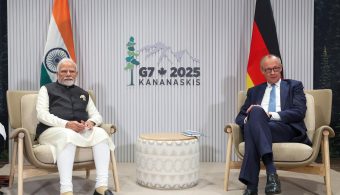Picture Source: Wikipedia
Indian Railways Conducts Historic Trial Run on World’s Highest Railway Bridge Chenab Bridge Sees Successful Trial Run of MEMU Train Indian Railways achieved a historic milestone on Thursday by successfully conducting a trial run of an eight-coach Mainline Electric Multiple Unit (MEMU) train on the Chenab Bridge, the world’s highest railway bridge located in Jammu and Kashmir.
This marks a significant advancement towards the commencement of rail operations on the Reasi-Baramulla route in Kashmir.
Successful Trial Run on Chenab Bridge
Following an extensive inspection of the newly constructed Chenab Bridge by senior officials from the Railway Board, Northern Railway, and Konkan Railway, a trial run was executed on a 46-km-long electrified section between Sangaldan in Ramban district and Reasi at a speed of 40 kmph.
The Ministry of Railways detailed the event in a statement, highlighting that the trial commenced at 12:35 PM from Sangaldan and reached Reasi at 2:05 PM, covering nine tunnels totaling 40.787 km, including the longest tunnel T-44, which spans 11.13 km.
Inaugural Full Train Crossing on Iconic Bridge
This trial marks the first full train crossing of the iconic Chenab Bridge, situated between Dugga and Bakkal stations over the Chenab River. Notably, the bridge is the highest arch railway bridge globally.
The key stations along this route—Reasi, Bakkal, Dugga, and Sawlakote—are all located in the Reasi district of Jammu & Kashmir.
State-of-the-Art Electrification Technology
The electrification work on this section was completed using state-of-the-art ROCS (Rigid Overhead Conductor System) technology at 25 kV, a first for Indian Railways.
The Udhampur-Srinagar-Baramulla Rail Link (USBRL) project, including the 48.1-km Banihal-Sangaldan section, was inaugurated by Prime Minister Narendra Modi on February 20, 2024.
Phased Project Implementation
The USBRL project has seen phased implementation. Phase-I, covering the 118 km Qazigund-Baramulla section, began in October 2009. Subsequent phases included the 18 km Banihal-Qazigund section in June 2013 and the 25 km Udhampur-Katra section in July 2014.
Earlier this year, the first electric train trial on the Banihal-Katra section from Banihal to Khari to Sangaldan in Ramban covered approximately 40 km of track and tunnels.
Integration and Development Benefits
Upon completion of a series of tests, the Chenab Bridge will support all train services, marking a monumental step towards seamlessly integrating the Kashmir valley with Jammu and the broader Indian rail network.
The Ministry emphasized that this development would foster social integration, ease the movement of people and goods, and promote cultural exchanges, regional development, and economic activities such as tourism and trade.
Significant Engineering Feats
Indian Railways has successfully laid a 272-km railway line from Udhampur to Baramulla, connecting Kashmir to the national rail network under the USBRL project.
Declared a ‘National Project’ in 2002, the USBRL project encompasses 38 tunnels covering a combined length of 119 km. The longest tunnel, T-49, spans 12.75 km, making it the country’s longest transportation tunnel.
Additionally, the project includes 927 bridges with a combined span of 13 km, featuring the Chenab Bridge, which has an overall length of 1315 meters, an arch span of 467 meters, and stands 359 meters above the riverbed, towering higher than the Eiffel Tower and recognized as the world’s highest arch railway bridge.



